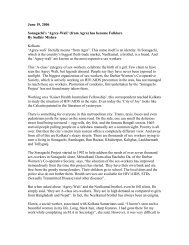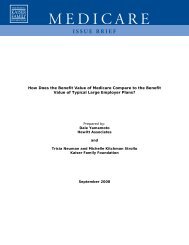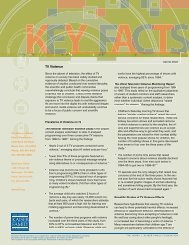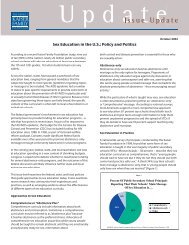HEALTH CARE COSTS: A PRimER - The Henry J. Kaiser Family ...
HEALTH CARE COSTS: A PRimER - The Henry J. Kaiser Family ...
HEALTH CARE COSTS: A PRimER - The Henry J. Kaiser Family ...
Create successful ePaper yourself
Turn your PDF publications into a flip-book with our unique Google optimized e-Paper software.
<strong>The</strong> ACA also has a number of provisions that address the costs and efficiency of the<br />
health care system, including provisions to demonstrate and implement new payment<br />
systems for Medicare (e.g., accountable care organizations, or ACOs), provisions to<br />
better coordinate care for people dually eligible for Medicare and Medicaid, reductions<br />
in Medicare payments, and new rules (e.g., disclosure and transparency) and new<br />
institutions (i.e., exchanges) to improve the efficiency of private health insurance.<br />
Despite the many cost-reducing provisions in the ACA, system-wide health care costs<br />
are still projected to rise faster than national income for the foreseeable future, and this<br />
cost growth has important implications for government and family budgets. Reducing<br />
future federal budget deficits is a major focus in national policy debate, and spending<br />
on federal health programs is a primary target. Federal health spending is projected to<br />
grow from 5.6% of Gross Domestic Product (GDP) in 2011 to about 9.4% of GDP by<br />
2035. 2 Proposals to reduce federal health spending range from modest reforms, such<br />
as modifying payment systems to better reward efficiency and effectiveness, to<br />
fundamental changes, such as transforming Medicaid into a block grant with capped<br />
federal spending and replacing the current Medicare entitlement with a defined set of<br />
services to a defined contribution toward purchase of a private or public health plan.<br />
Recent proposals to reduce future budget deficits include various policies to slow<br />
federal health spending, including taking steps to constrain overall federal spending to<br />
a proscribed rate of growth, such as one percentage point above GDP or GDP per<br />
capita. 3 <strong>The</strong> more far-reaching reforms would limit federal costs and potentially expose<br />
program beneficiaries to higher out-of-pocket costs and benefit reductions. Many<br />
states have experienced severe budget problems during the recent recession, leading<br />
them to reduce state spending on Medicaid, which is one of the largest components of<br />
state budgets.<br />
<strong>The</strong> federal budget debate in large part revolves around the overall size of the budget<br />
and the mix of program cuts and new revenues necessary to bring federal spending<br />
into better balance. Proposals to reduce federal health spending are based on the<br />
premise that health programs are growing to unaffordable levels and must be curtailed.<br />
Little of the debate, however, considers the amount of health that is currently provided<br />
by these programs and how much health the nation wants to support though federal<br />
spending in the future. Health spending grows faster than national income in part<br />
because the health care system continues to innovate and provide new treatment<br />
options to people with serious acute and chronic illnesses. A system that each year<br />
can do more of something that people find very valuable – address their health care<br />
needs – inevitably will attract a greater share of overall national spending. This does<br />
not mean that all current health care spending is necessary or that there are not<br />
considerable opportunities to improve the efficiency and quality of care, but even from<br />
more efficient levels continuing innovation will push costs higher as the arsenal of<br />
health care interventions continues to grow. <strong>The</strong> key challenge for policymakers will be<br />
finding the best mix of policies so that government, corporate, and private health<br />
spending is as efficient as possible and best meets the health care needs and desires<br />
of the nation.<br />
<strong>The</strong> challenge is made more difficult by the highly decentralized nature of health care<br />
decision-making in the United States. Health care investment and spending are<br />
influenced by federal and state programs with differing payment systems, incentives,<br />
and reimbursement levels; by numerous private health insurers, each with their own<br />
2 THE HENRY J. KAISER FAMILY FOUNDATION












